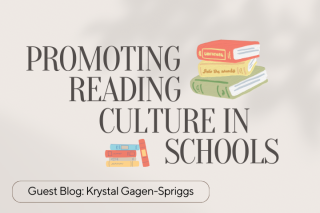- Your School Type
- Solutions
- Resources
- Blog
- Events
- More
- Contact Us
- Book a Demo
- Get a Quote

Guest Blog: Krystal Gagen-Spriggs, a skilled Lecturer in the School of Information and Communication Studies, specialises in school libraries and promoting reading pleasure. Currently pursuing her PhD, her research focuses on reading cultures, teacher librarians' influence, and engaging reluctant readers. With experience as a teacher-librarian and dual Master of Education degrees, Krystal is dedicated to enhancing literacy in education.
Strategies and success stories about how schools can encourage reading.
Teacher librarians (TLs) are integral to a strong reading culture. They are the glue that can bring together a school as a community of readers through their passion and expertise in children’s and young adult literature. TLs are employed as supporters and developers of reading for pleasure in schools, with employers actively seeking TLs who are wildly enthusiastic about reading (Merga & Ferguson, 2021). Evidently, the expertise of TLs is key in developing and maintaining a strong reading culture, but there are also four things that TLs can either incorporate or improve on to strengthen their influence on the reading habits, and therefore reading culture, of their schools.
Young people really like it when you show interest in them and their likes or dislikes. They want connection and to be understood. TLs need to acknowledge the power in student-centred conversations and meeting students where they are at (Merga, 2015). This will help TLs to develop close relationships with their students, which will lead to a potential increase in students reading for pleasure. Young people love when a TL can produce a book for them (Gagen-Spriggs, 2020). It’s even more exciting when the student feels like the TL has selected that book ‘just for them,’ making this interaction personal. This is almost a type of magic that TLs do, and it is not new, as TLs all around the world regularly talk about finding the right book for the right student, but students still feel seen and appreciated when this happens. So, don’t underestimate the power of getting to know your students and what they like!
It should come as no surprise that enthusiasm and passion is catchy. A TL who can talk passionately about reading is far more likely to engage young people in reading than one who can’t. This might not be something that all TLs feel comfortable doing, but it is an important skill for all TLs to master. Students have reported that TLs who can talk about why they love reading, the struggles they face in reading, how they overcame them, and what they like reading are more likely to get students to open up about their own likes or dislikes, successes or struggles, and create more meaningful connections.
Despite many TLs knowing and advocating for diverse collections and reading material, some members of school communities still have very strict ideas on what is considered appropriate reading material for young people. While we might want all our students to be capable of reading complex and sophisticated literature, the reality is that for some students, that is a daunting task which puts them off trying in the first place. It’s important, therefore, that school library collections represent the diversity of the student body. Representation of the full human experience is key and should include stories with characters from diverse backgrounds (Lin et al., 2021), but also should acknowledge the way that different cultures tell, share, and preserve stories (Dali et al., 2020). Additionally, school library collections should provide:
By having a truly diverse and representative collection, TLs can have a positive influence on the reading culture within their schools.
One of the key factors preventing young people from reading is a lack of time available to them. Our students are busier than ever. The struggle of balancing schoolwork, extra-curricular activities, social lives, and downtime means that many young people are finding it difficult to schedule time into their day for reading. Having conversations with young people about how to schedule this time, as well as why it’s important to make the time to read is a vital strategy that TLs need to prioritise (Lin et al., 2021). Having the best, diverse and engaging collections will not be sufficient if young people are not able to fit reading into their days, so helping them do this must be a priority for TLs.
Evidently, there are many different things that TLs and school libraries can do to help support a healthy reading culture in their schools. What is most important to acknowledge is that each school and TL will do things slightly differently, and that’s ok! A healthy reading culture, much like a dynamic school library collection, should reflect the needs of the school community. Therefore, what works in one school may not work for another. The most important thing is that TLs should always be striving to do what’s best for their students.
Bishop, R. S. (1990). Mirrors-Windows-and-Sliding-Glass-Doors.pdf. Perspectives: Choosing and Using Books for the Classroom, 6(3). https://scenicregional.org/wp-content/uploads/2017/08/Mirrors-Windows-and-Sliding-Glass-Doors.pdf
Dali, K., Vannier, C., & Douglass, L. (2020). Reading experience librarianship: Working with readers in the 21st century. Journal of Documentation, 77(1), 259–283. https://doi.org/10.1108/JD-06-2020-0105
Gagen-Spriggs, K. (2020). An investigation into the reasons students read for pleasure. School Libraries Worldwide, 20(1), 15. https://doi.org/doi: 10.14265.26.1.009
Lin, J., Li, Q., Sun, H., Huang, Z., & Zheng, G. (2021). Chinese secondary school students’ reading engagement profiles: Associations with reading comprehension. Reading and Writing, 34(9), 2257–2287. https://doi.org/10.1007/s11145-021-10139-4
Merga, M. K. (2015). “She knows what I like”: Student-generated best-practice statements for encouraging recreational book reading in adolescents. Australian Journal of Education, 59(1), 35–50. https://doi.org/10.1177/0004944114565115
Merga, M. K., & Ferguson, C. (2021). School librarians supporting students’ reading for pleasure: A job description analysis. Australian Journal of Education, 65(2), 153–172. https://doi.org/10.1177/0004944121991275